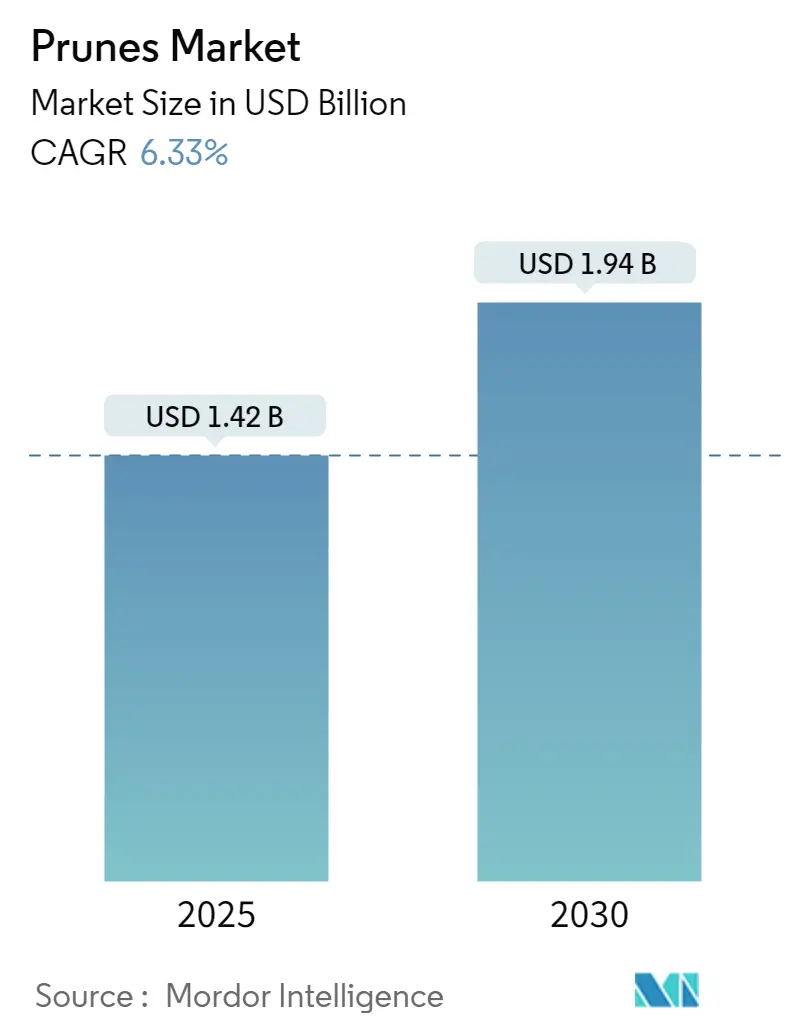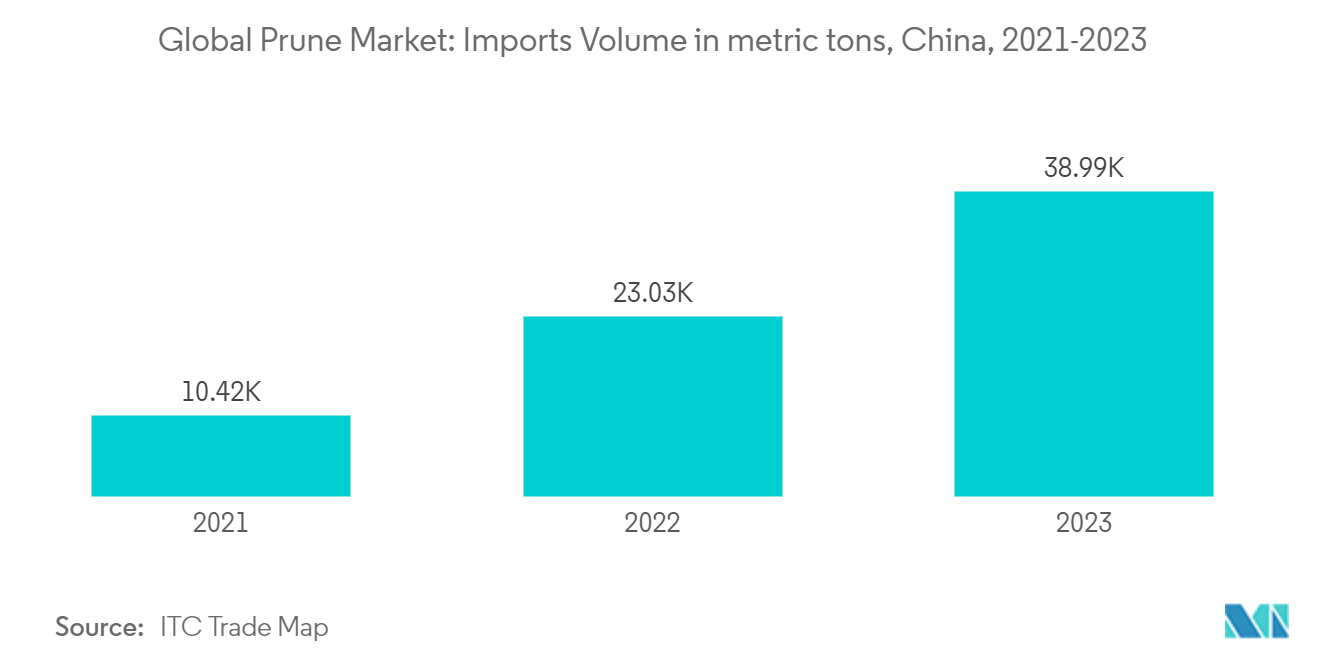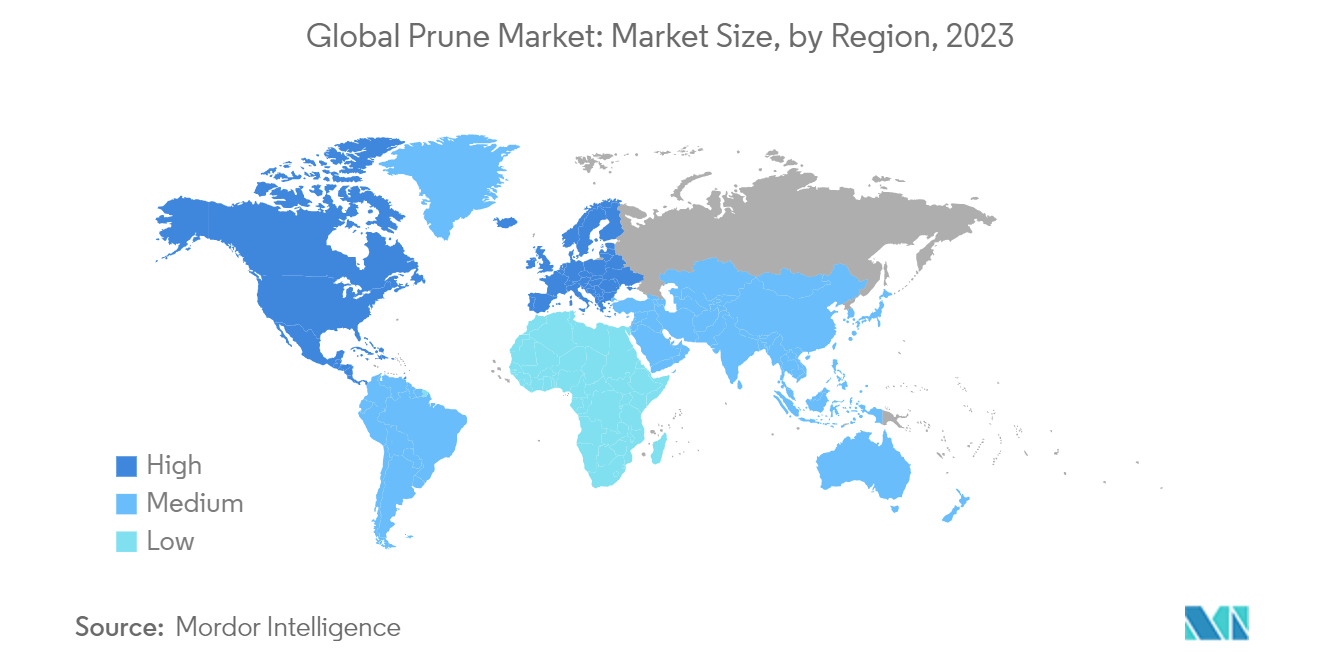Prunes Market Size and Share

Prunes Market Analysis by Mordor Intelligence
The Prunes Market size is estimated at USD 1.42 billion in 2025, and is expected to reach USD 1.94 billion by 2030, at a CAGR of 6.33% during the forecast period (2025-2030).
- Prunes, essentially dried plums, thrive in sub-tropical to temperate climates. Major producers include Chile, the United States, Iran, and Uzbekistan. Data from the International Nuts and Dried Fruit Council reveals that in the 2022-2023 period, prunes represented 6% of the global dried fruit output, totaling 171,660 metric tons. Chile and the United States accounted for 74% of this production.
- Chile and the United States, the leading producers of prunes, also play a significant role as major exporters. Data from the ITC Trade Map reveals that 2023 global prune exports reached 191,954 metric tons, with Chile and the United States accounting for a combined 49% share. The rising export demand can be attributed to the nutritional benefits of prunes and the introduction of innovative prune products catering to vegan diets. Prunes are rich in fiber and potassium, which help maintain bone density. Their long shelf life increases market demand, especially as consumers seek quicker, healthier dietary options.
- Moreover, the primary consumers of prunes include countries like the United States and France. In 2021, global per capita consumption of prunes was recorded at 0.032 kg, translating to a total consumption volume of 191,456 metric tons, as per data from the International Nuts and Dried Fruits Council. A surge in demand for prunes in China has been observed, leading to increased imports from Chile and the United States. ITC Trade Map data indicates that in 2023, China imported 38,990 metric tons of prunes, marking a 69.3% increase from the previous year's 23,031 metric tons.
Global Prunes Market Trends and Insights
Rising Imports are Fueling the Market
Prunes contain less sugar than many other dried fruits. While it is commonly believed that carb-rich fruits can spike blood sugar, prunes do not trigger such surges. Each prune offers 1 gram of fiber, contributing to 3% of the daily fiber intake, and contains over 6 grams of carbohydrates. These health benefits are fueling a surge in global imports. The ITC Trade Map data reveals that 2023 worldwide imports reached 190,678 metric tons, a 9.3% increase from 2021 figures. China represented 20.4% of the total import volume in 2023.
In 2023, prune production declined while imports surged due to increased demand from China, causing a price spike. Chile's prune production grappled with challenges: a warm winter, a cool spring, and an intense summer. Yet, in a twist, Chile ramped up its prune exports, primarily to cater to the Chinese market. The ITC Trade Map data highlights a significant jump in imports from Chile to China, soaring from 9,814 metric tons in 2022 to 18,627 metric tons in 2023.
Chinese consumers, increasingly health-conscious, are turning to prune-based products, including prune juice and snacks. Prunes, rich in beta carotene (which the body converts to vitamins A, B, and K), also boast potassium, zinc, iron, calcium, magnesium, manganese, and copper. They can be enjoyed whole or as enhancements in processed foods. Prunes captured nearly 13.5% of high-income economies' global dry fruit consumption share. Given this rising global acknowledgment of prunes' health benefits, the market is poised for growth in the coming years.

The United States May Dominate the Prunes Market
The United States is one of the world's leading producers and consumers of prunes. While the United States exports a substantial amount of prunes, it also imports them from Chile to meet its high domestic demand. Data from the ITC Trade Map highlights that in 2022, the United States ranked among the top global exporters of prunes. The export value of US prunes reached USD 169,142 in 2022, marking a 38% increase from USD 122,499 in 2020. The United States produces several grades of dried prunes, classified by the USDA as US Grade A (or US Fancy), US Grade B (or US Choice), US Grade C (or US Standard), and Substandard.
California dominates prune production in the United States. California is renowned for producing some of the world's finest prunes and boasts its own California Prune Board. This board is pivotal in connecting prune farmers to global markets, ensuring they can sell premium prunes at better prices. Beyond fresh prunes, the California Prune Board also markets processed products, including prune paste, puree, diced prunes, bits, concentrate, butter, and powder. According to the California Prune Board, California produces 99% of the nation's prunes and contributes 40% of the global supply.
Prunes are one of the most consumed dried fruits in the United States, second only to dates. With a growing emphasis on healthier, locally sourced food, US schools are increasingly purchasing dried plums. These versatile fruits can be enjoyed whole or used to enhance processed foods. Rising health consciousness, especially among millennials, drives this increase in prune consumption. Given the robust marketing efforts and abundant domestic supply, US prune production and exports are poised for growth in the coming years.

Recent Industry Developments
- April 2024: The United Kingdom removed the 16% import tariff on California prune juice, benefiting the California Prune Board and UK consumers.
- August 2023: In the first half of 2023, imports of prunes from Chile to China surged dramatically. The volume saw a remarkable 278% increase, while the value rose by 270% compared to the previous year.
Global Prunes Market Report Scope
Prune is defined as a dried plum of any cultivar, mostly the European plum. Not all plums are suitable for drying into prunes. The term "prune" for fresh plums is no longer used except for varieties grown for drying.
The prunes market is segmented by geography into the United States, Mexico, Brazil, Argentina, Chile, Germany, the United Kingdom, Italy, Russia, France, Poland, Algeria, China, Japan, and Australia. The report includes production (volume), consumption (value and volume), and trade analysis. The report offers market estimation and forecasts in value (USD) and volume (metric tons) for the above segments.
| United States | Production Analysis |
| Consumption Analysis and Market Value | |
| Import Market Analysis (Volume and Value) | |
| Export Market Analysis (Volume and Value) | |
| Price Trend Analysis | |
| Mexico | Production Analysis |
| Consumption Analysis and Market Value | |
| Import Market Analysis (Volume and Value) | |
| Export Market Analysis (Volume and Value) | |
| Price Trend Analysis | |
| Brazil | Production Analysis |
| Consumption Analysis and Market Value | |
| Import Market Analysis (Volume and Value) | |
| Export Market Analysis (Volume and Value) | |
| Price Trend Analysis | |
| Argentina | Production Analysis |
| Consumption Analysis and Market Value | |
| Import Market Analysis (Volume and Value) | |
| Export Market Analysis (Volume and Value) | |
| Price Trend Analysis | |
| Chile | Production Analysis |
| Consumption Analysis and Market Value | |
| Import Market Analysis (Volume and Value) | |
| Export Market Analysis (Volume and Value) | |
| Price Trend Analysis | |
| Germany | Production Analysis |
| Consumption Analysis and Market Value | |
| Import Market Analysis (Volume and Value) | |
| Export Market Analysis (Volume and Value) | |
| Price Trend Analysis | |
| United Kingdom | Production Analysis |
| Consumption Analysis and Market Value | |
| Import Market Analysis (Volume and Value) | |
| Export Market Analysis (Volume and Value) | |
| Price Trend Analysis | |
| Italy | Production Analysis |
| Consumption Analysis and Market Value | |
| Import Market Analysis (Volume and Value) | |
| Export Market Analysis (Volume and Value) | |
| Price Trend Analysis | |
| Russia | Production Analysis |
| Consumption Analysis and Market Value | |
| Import Market Analysis (Volume and Value) | |
| Export Market Analysis (Volume and Value) | |
| Price Trend Analysis | |
| France | Production Analysis |
| Consumption Analysis and Market Value | |
| Import Market Analysis (Volume and Value) | |
| Export Market Analysis (Volume and Value) | |
| Price Trend Analysis | |
| Poland | Production Analysis |
| Consumption Analysis and Market Value | |
| Import Market Analysis (Volume and Value) | |
| Export Market Analysis (Volume and Value) | |
| Price Trend Analysis | |
| Uzbekistan | Production Analysis |
| Consumption Analysis and Market Value | |
| Import Market Analysis (Volume and Value) | |
| Export Market Analysis (Volume and Value) | |
| Price Trend Analysis | |
| China | Production Analysis |
| Consumption Analysis and Market Value | |
| Import Market Analysis (Volume and Value) | |
| Export Market Analysis (Volume and Value) | |
| Price Trend Analysis | |
| Japan | Production Analysis |
| Consumption Analysis and Market Value | |
| Import Market Analysis (Volume and Value) | |
| Export Market Analysis (Volume and Value) | |
| Price Trend Analysis | |
| Australia | Production Analysis |
| Consumption Analysis and Market Value | |
| Import Market Analysis (Volume and Value) | |
| Export Market Analysis (Volume and Value) | |
| Price Trend Analysis |
| Geography | United States | Production Analysis |
| Consumption Analysis and Market Value | ||
| Import Market Analysis (Volume and Value) | ||
| Export Market Analysis (Volume and Value) | ||
| Price Trend Analysis | ||
| Mexico | Production Analysis | |
| Consumption Analysis and Market Value | ||
| Import Market Analysis (Volume and Value) | ||
| Export Market Analysis (Volume and Value) | ||
| Price Trend Analysis | ||
| Brazil | Production Analysis | |
| Consumption Analysis and Market Value | ||
| Import Market Analysis (Volume and Value) | ||
| Export Market Analysis (Volume and Value) | ||
| Price Trend Analysis | ||
| Argentina | Production Analysis | |
| Consumption Analysis and Market Value | ||
| Import Market Analysis (Volume and Value) | ||
| Export Market Analysis (Volume and Value) | ||
| Price Trend Analysis | ||
| Chile | Production Analysis | |
| Consumption Analysis and Market Value | ||
| Import Market Analysis (Volume and Value) | ||
| Export Market Analysis (Volume and Value) | ||
| Price Trend Analysis | ||
| Germany | Production Analysis | |
| Consumption Analysis and Market Value | ||
| Import Market Analysis (Volume and Value) | ||
| Export Market Analysis (Volume and Value) | ||
| Price Trend Analysis | ||
| United Kingdom | Production Analysis | |
| Consumption Analysis and Market Value | ||
| Import Market Analysis (Volume and Value) | ||
| Export Market Analysis (Volume and Value) | ||
| Price Trend Analysis | ||
| Italy | Production Analysis | |
| Consumption Analysis and Market Value | ||
| Import Market Analysis (Volume and Value) | ||
| Export Market Analysis (Volume and Value) | ||
| Price Trend Analysis | ||
| Russia | Production Analysis | |
| Consumption Analysis and Market Value | ||
| Import Market Analysis (Volume and Value) | ||
| Export Market Analysis (Volume and Value) | ||
| Price Trend Analysis | ||
| France | Production Analysis | |
| Consumption Analysis and Market Value | ||
| Import Market Analysis (Volume and Value) | ||
| Export Market Analysis (Volume and Value) | ||
| Price Trend Analysis | ||
| Poland | Production Analysis | |
| Consumption Analysis and Market Value | ||
| Import Market Analysis (Volume and Value) | ||
| Export Market Analysis (Volume and Value) | ||
| Price Trend Analysis | ||
| Uzbekistan | Production Analysis | |
| Consumption Analysis and Market Value | ||
| Import Market Analysis (Volume and Value) | ||
| Export Market Analysis (Volume and Value) | ||
| Price Trend Analysis | ||
| China | Production Analysis | |
| Consumption Analysis and Market Value | ||
| Import Market Analysis (Volume and Value) | ||
| Export Market Analysis (Volume and Value) | ||
| Price Trend Analysis | ||
| Japan | Production Analysis | |
| Consumption Analysis and Market Value | ||
| Import Market Analysis (Volume and Value) | ||
| Export Market Analysis (Volume and Value) | ||
| Price Trend Analysis | ||
| Australia | Production Analysis | |
| Consumption Analysis and Market Value | ||
| Import Market Analysis (Volume and Value) | ||
| Export Market Analysis (Volume and Value) | ||
| Price Trend Analysis | ||
Key Questions Answered in the Report
How big is the Prunes Market?
The Prunes Market size is expected to reach USD 1.42 billion in 2025 and grow at a CAGR of 6.33% to reach USD 1.94 billion by 2030.
What is the current Prunes Market size?
In 2025, the Prunes Market size is expected to reach USD 1.42 billion.
Which is the fastest growing region in Prunes Market?
Europe is estimated to grow at the highest CAGR over the forecast period (2025-2030).
Which region has the biggest share in Prunes Market?
In 2025, the North America accounts for the largest market share in Prunes Market.
What years does this Prunes Market cover, and what was the market size in 2024?
In 2024, the Prunes Market size was estimated at USD 1.33 billion. The report covers the Prunes Market historical market size for years: 2019, 2020, 2021, 2022, 2023 and 2024. The report also forecasts the Prunes Market size for years: 2025, 2026, 2027, 2028, 2029 and 2030.
Page last updated on:
Prunes Market Report
Statistics for the 2025 Prunes market share, size and revenue growth rate, created by Mordor Intelligence™ Industry Reports. Prunes analysis includes a market forecast outlook for 2025 to 2030 and historical overview. Get a sample of this industry analysis as a free report PDF download.

